Here’s the 2021 Tour de France route and reference guide. Yes the Tour de Suisse is still on and so is the Tour of Slovenia but all roads lead to Brittany at the moment.
There’s a profile of every stage with a quick summary of the day’s course. You’ll also find references for time bonuses, the points scale for the green and polka-dot jersey, time cuts, prize money and plenty more. If you want to come back between now and July, just visit inrng.com/tour or click on the Tour guide from the menu above.
Route Summary
Three summit finishes, eight likely sprint finishes and two solo time trials makes the 2021 Tour route look a bit more traditional. It is a reset on the Tour’s trend for more mountains and fewer time trials and there’s the most amount of TT kilometres since 2013 but that’s the comparison, a route like 2013 or perhaps 2016 rather than anything more retro. All grand tours are backloaded and this one has only a quick dash in and out of the Alps before Mont Ventoux. The hard final week spends most of the time in the Pyrenees before a time trial in the Bordeaux vineyards to settle things.
Stage 1 – Saturday 26 June
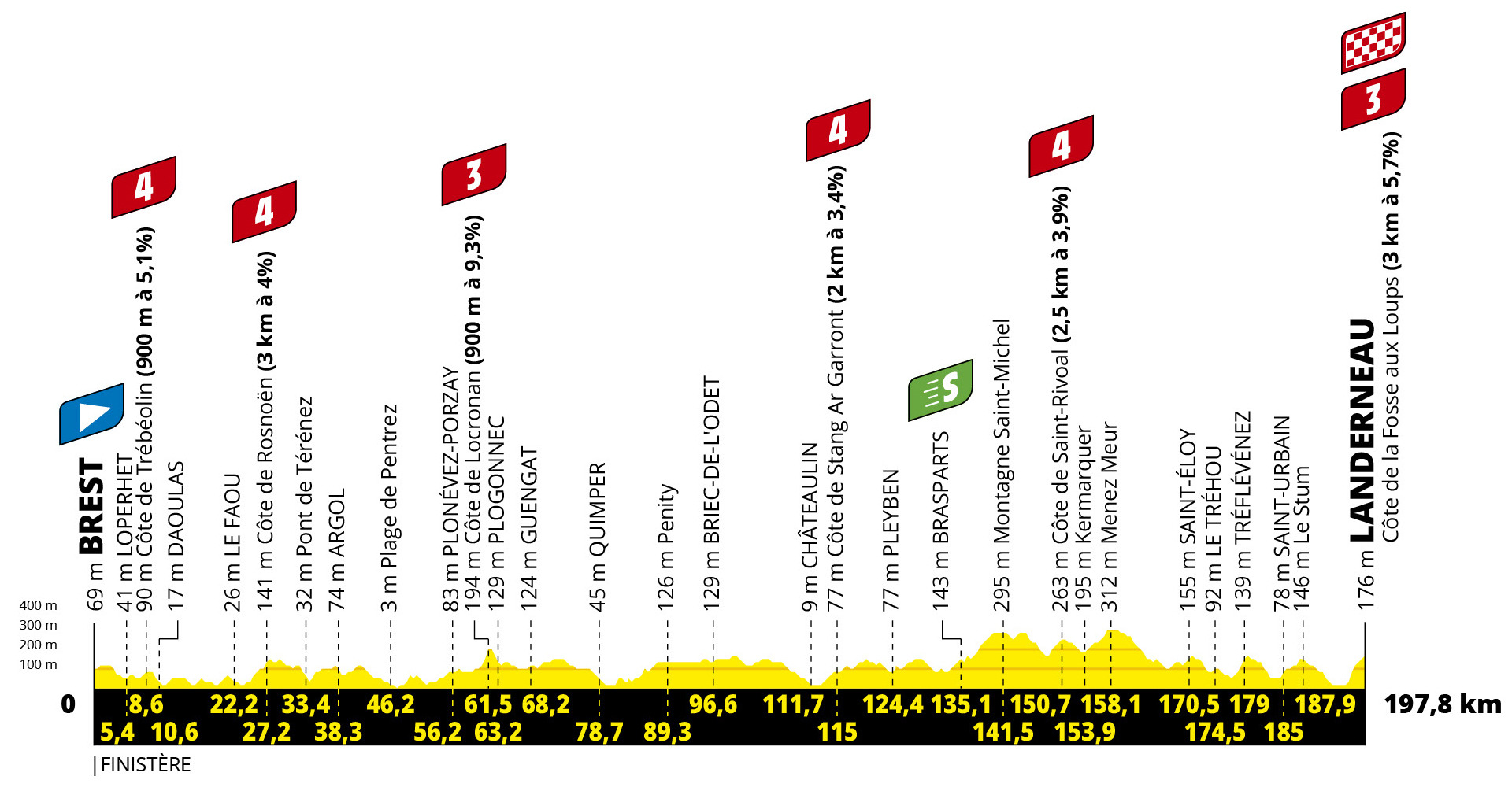
A very Breton stage with cities and wild coastlines alike. It’s made for punchy riders with a 3km uphill finish that’s steep at the start, it’s open to the cast of contenders from the most athletic sprinters to the overall contenders with plenty of punchy riders in between but Mathieu van der Poel looks like the obvious pick.
Stage 2 – Sunday 27 June
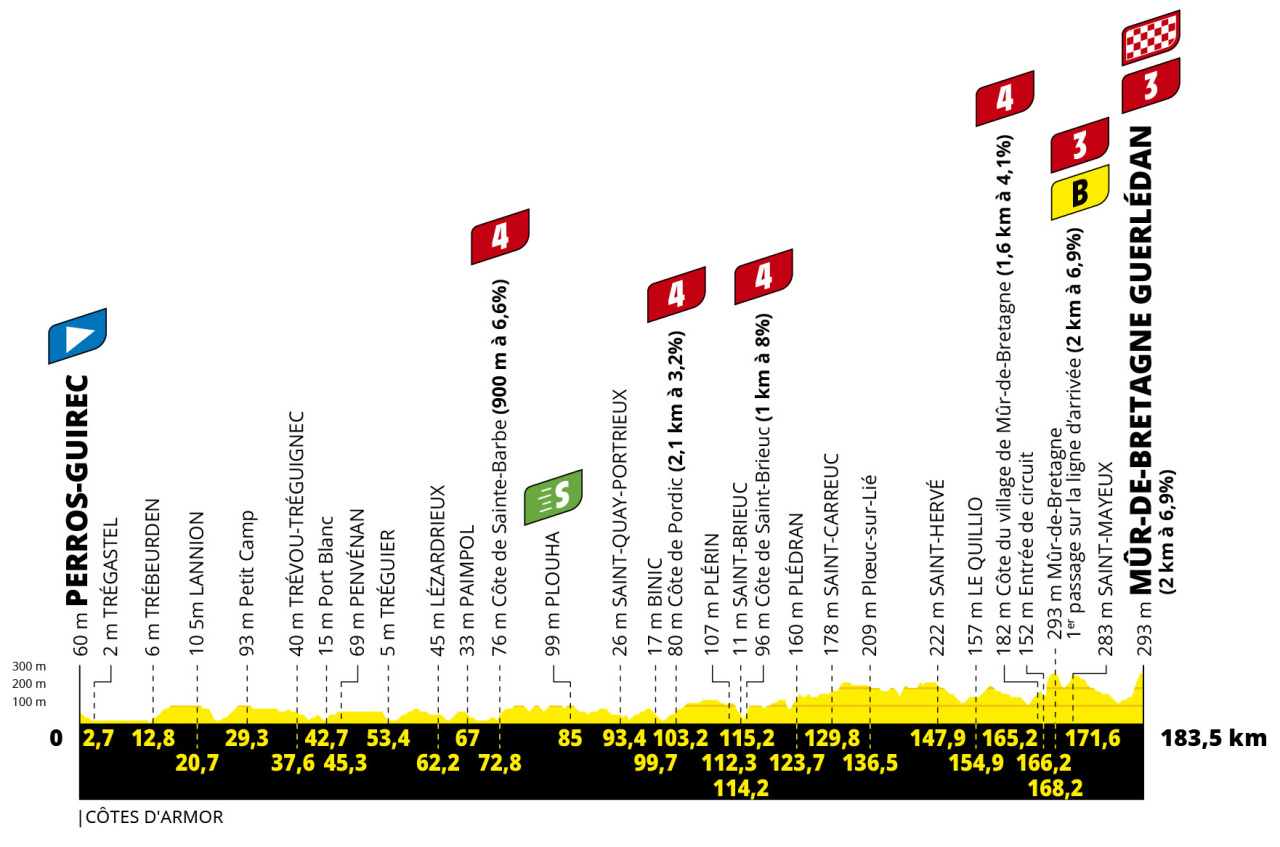
Another hard, hilly day in Brittany with an uphill finish, this time at Mûr-de-Bretagne, a regular spot for the Tour in recent years.
Stage 3 – Monday 28 June
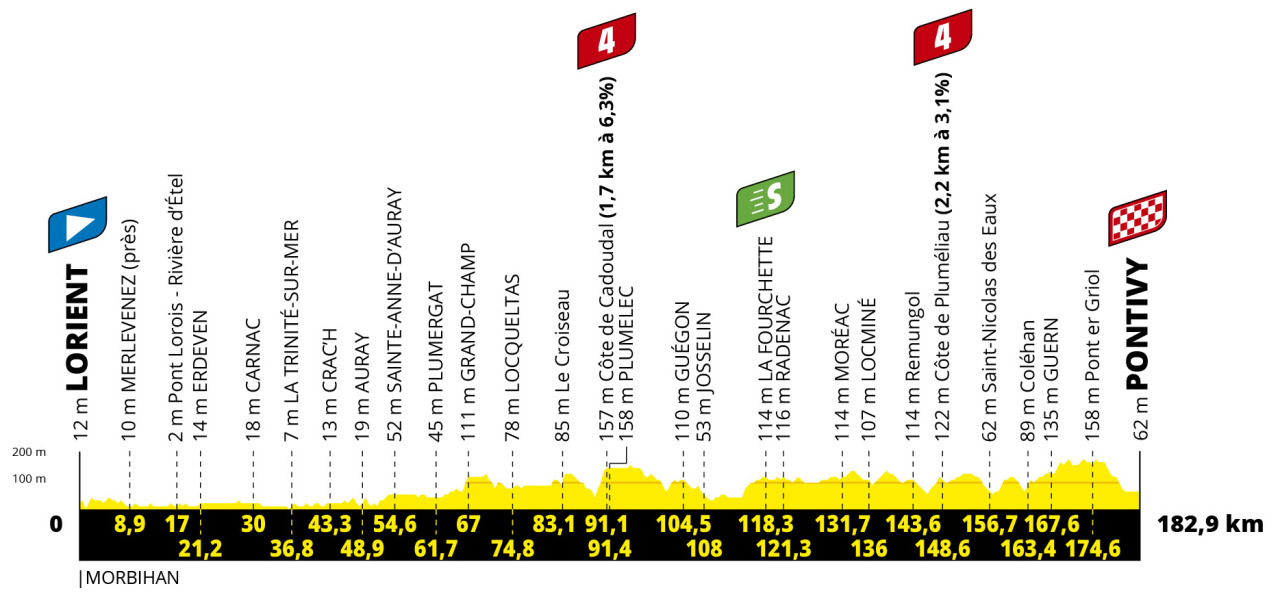
One for the sprinters but this is no dragster course, it’s full of twisting, narrow roads on the way to the finish in Pontivy.
Stage 4 – Tuesday 29 June

Another for the sprinters, this time a more predictable one on roads regularly used by the peloton whether in the Tour or rounds of the Coupe de France.
Stage 5 – Wednesday 30 June

The Tour has an unofficial rule for course design these days: no more than two sprint stages in a row otherwise it’s boring. So what to do when you’re crossing a flat part of France? Have a TT and this is a big day for the overall classification. To call this a hard course is excessive but the route’s as hilly as possible given the flat terrain and has a tricky kick in the finish.
Stage 6 – Thursday 1 July
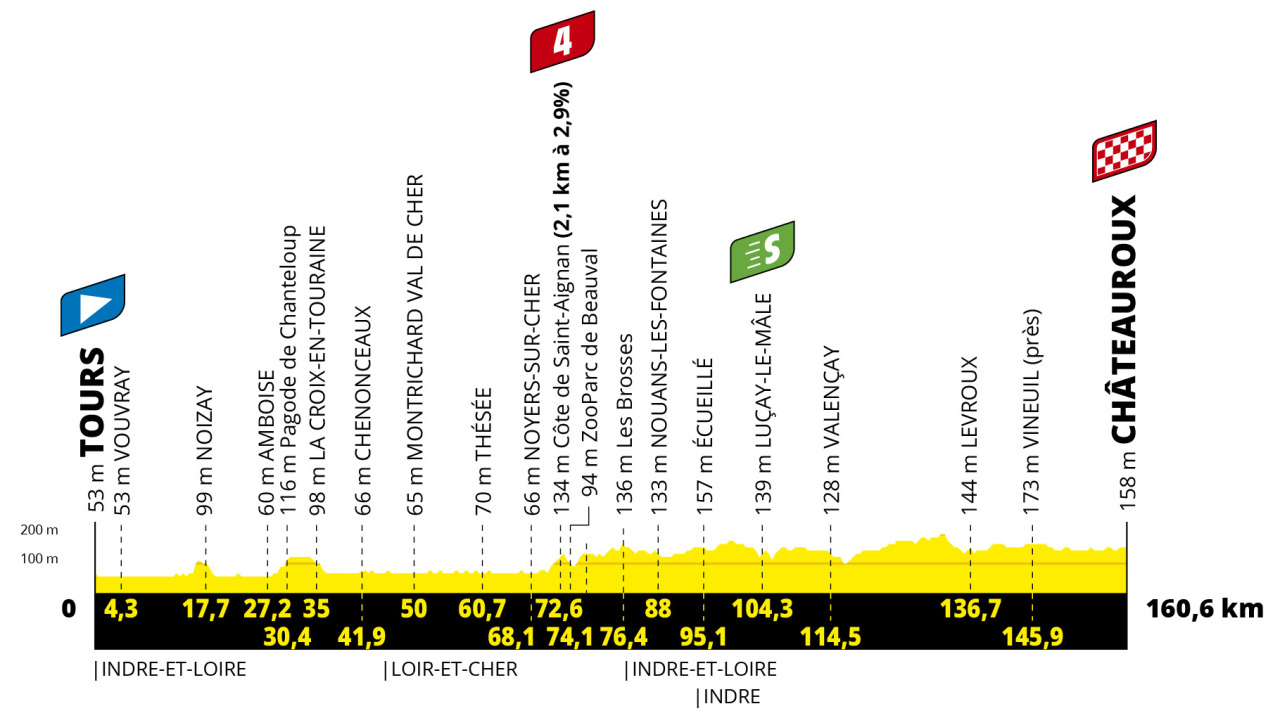
Another one for the sprinters across flat terrain. After the town of Valençay famous for its goats cheese and Talleyrand’s castle, it’s one straight road for 40km to the sleepy town of Châteauroux, famous for… well not too much. Actor Gérard Depardieu was born here and Mark Cavendish took his first ever Tour de France stage here in 2008… and won again when the race returned in 2011.
Stage 7 – Friday 2 July
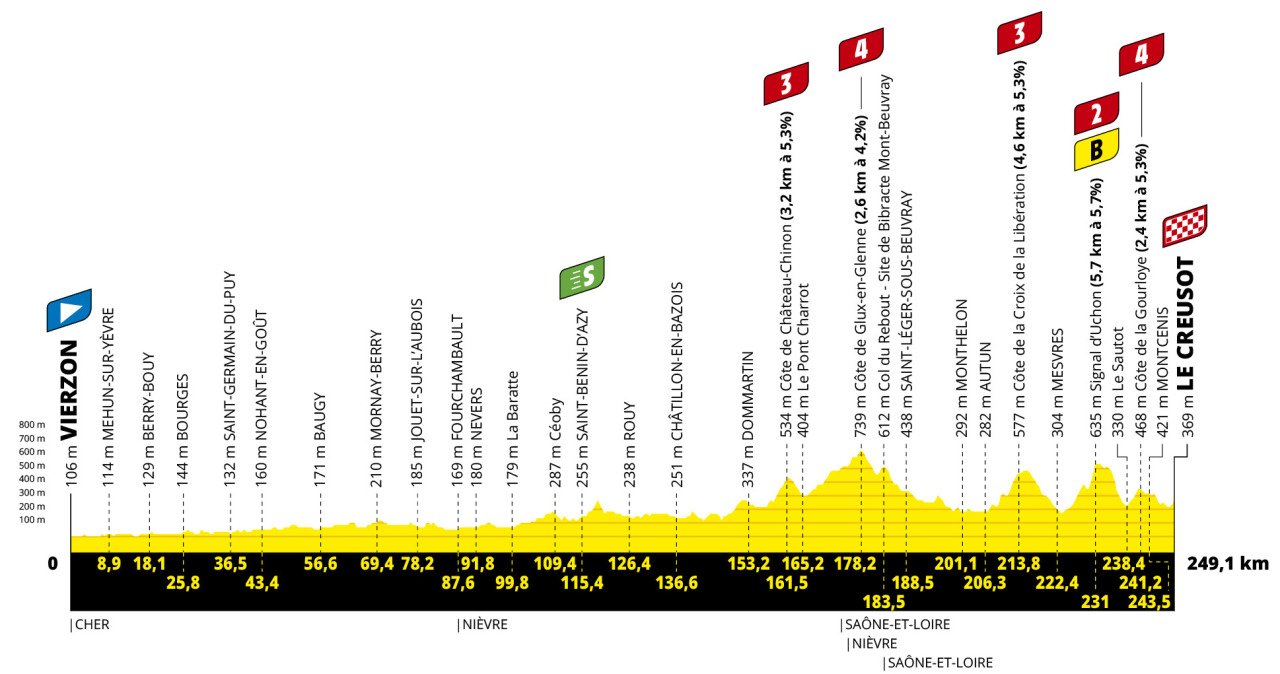
The longest stage of the race and a hard finish across the Morvan, a small and rugged mountain range, with the Signal d’Uchon as the focal point, a tough climb after 220km and a stage to reward the breakaway.
Stage 8 – Saturday 3 July
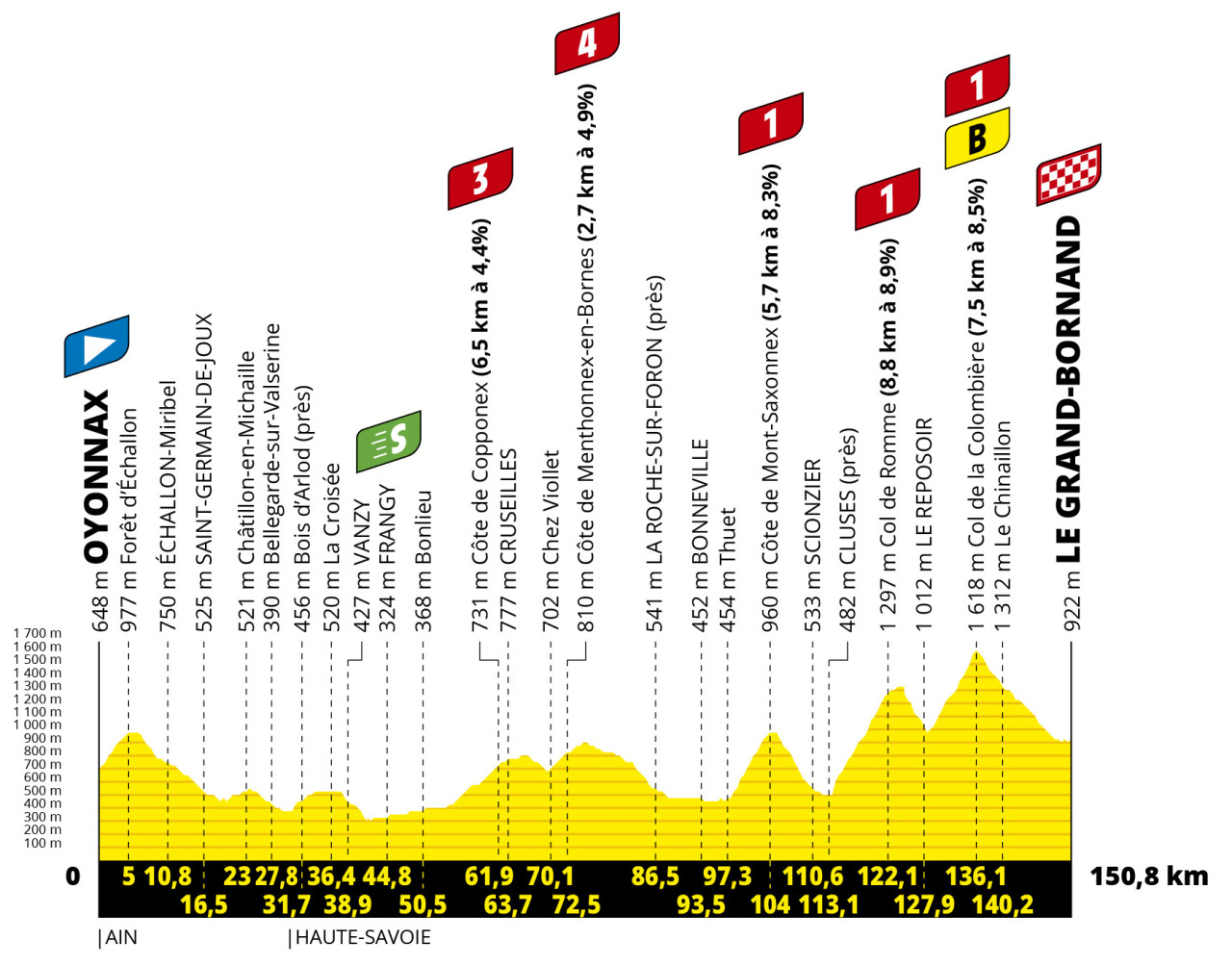
The first Alpine stage and there’s plenty packed into 150km. Uphill out of the Jura mountains, the first climb of the day is unmarked but it’s bigger than any climb in the previous stages. Then it’s across the foothills and the final 60km are where the GC action starts, there’s a “new” climb via the Gorges du Bronze labelled Mont-Saxonnex that’s harder than suggested, complete with a narrow approach where a contender out of position here is in trouble. There’s only a short descent into the steep Romme-Colombière combo before the toboggan descent to Le Grand Bornand.
Stage 9 – Sunday 4 July
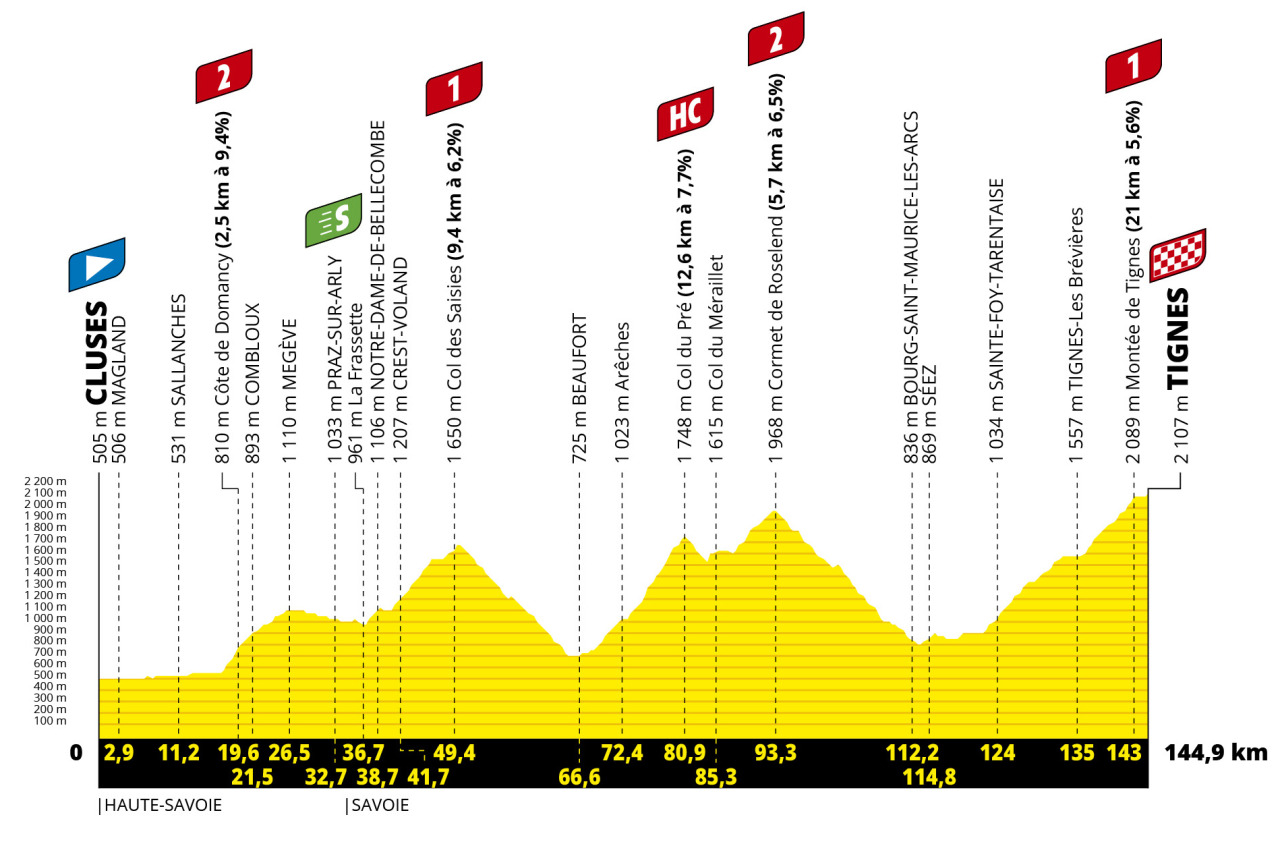
Remember the 2019 Tour de France and the landslides that blocked roads for the final two mountain stages? This stage makes amends, crossing where the race could not. This is a short but scenic Alpine stage where the mountains competition labels really don’t tell the story, the Roselend is much harder than Domancy, the Col du Pré is tough but surely not HC-hard? The final climb is much of the Col de l’Iseran before then off for Tignes, a long and gradual drag up to a high altitude finish that will suit stronger teams rather than lone climbers.
Stage 10 – Tuesday 6 July
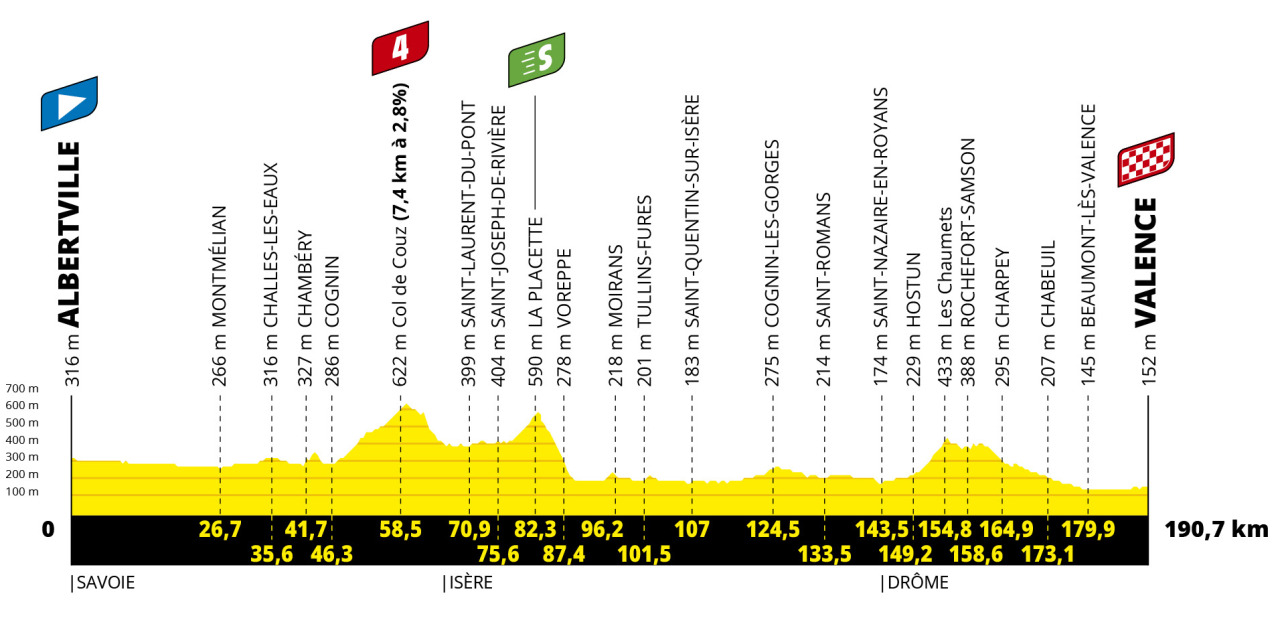
The Tour leaves the Alps to the relief of the sprinters who should get their reward in Valence, watch for the Mistral wind.
Stage 11 – Wednesday 7 July
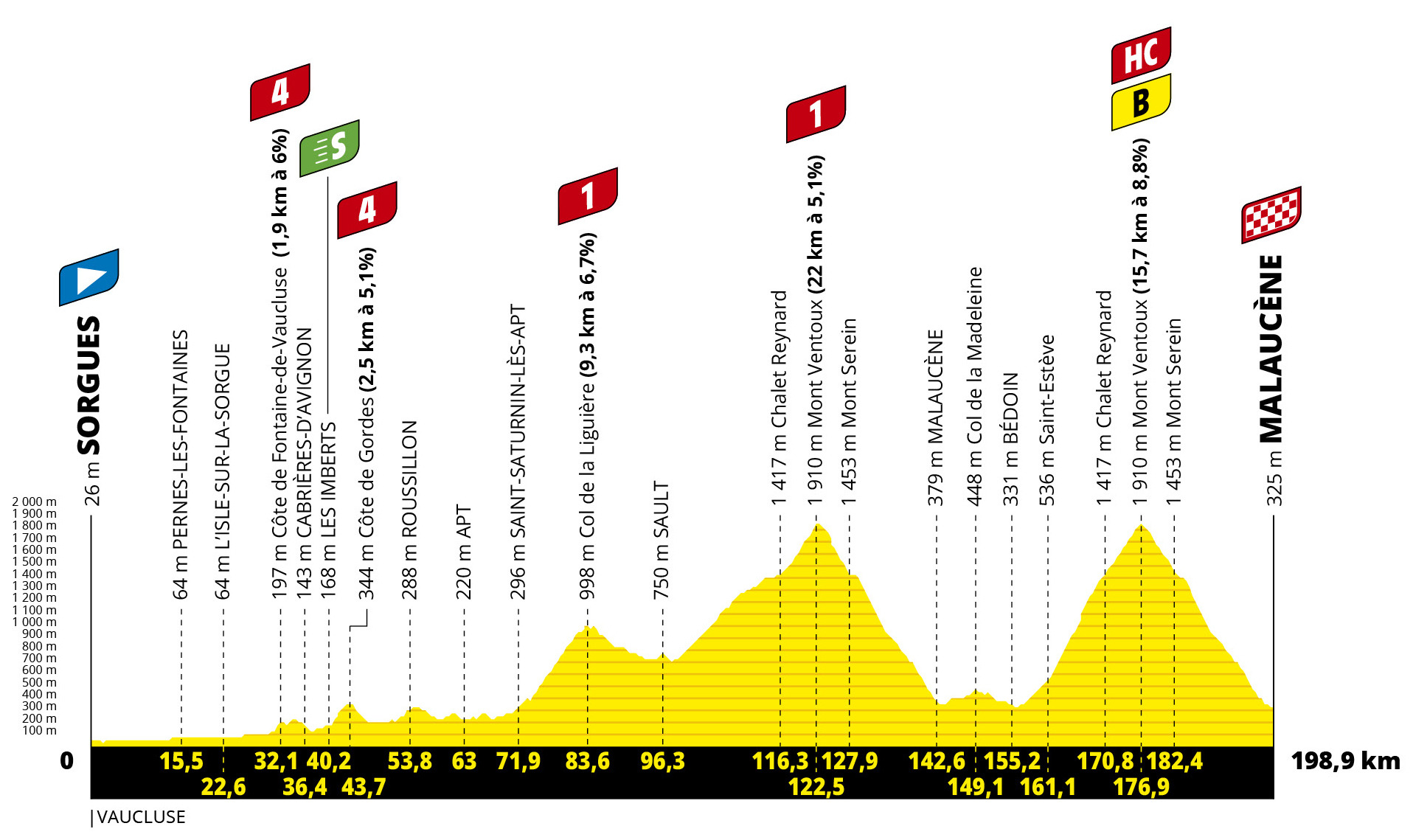
The Ventoux one-two with the mountain climbed twice, first from the gentlest side via Sault, and a practice down the Cresta Run-style descent to Malaucène, then the traditional route from Bédoin before the downhill back to Malaucène again.
Stage 12 – Thursday 8 July
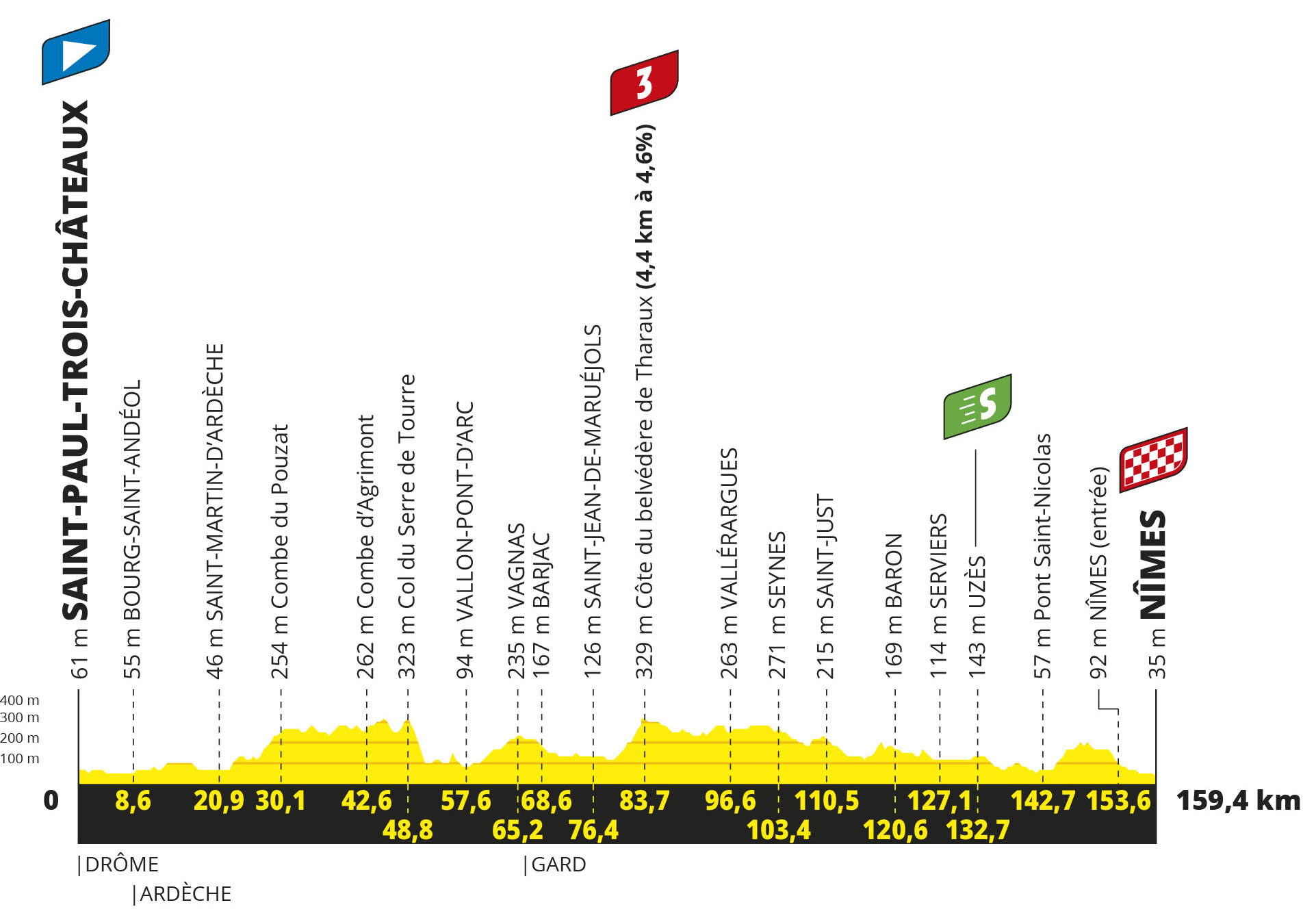
A start in Saint-Paul-Trois-Châteaux which sounds charming, evoking images of an old town with three castles and it is nice… but local views can be dominated not by castles but by the giant cooling tower of the Tricastin nuclear plant. A likely sprint stage with the usual caveats if the Mistral crosswind blows. Watch out for the unmarked climb out of the Gordon gorge with 10km to go, this is a good spot for some teams to ambush the heavyset sprinters.
Stage 13 – Friday 9 July
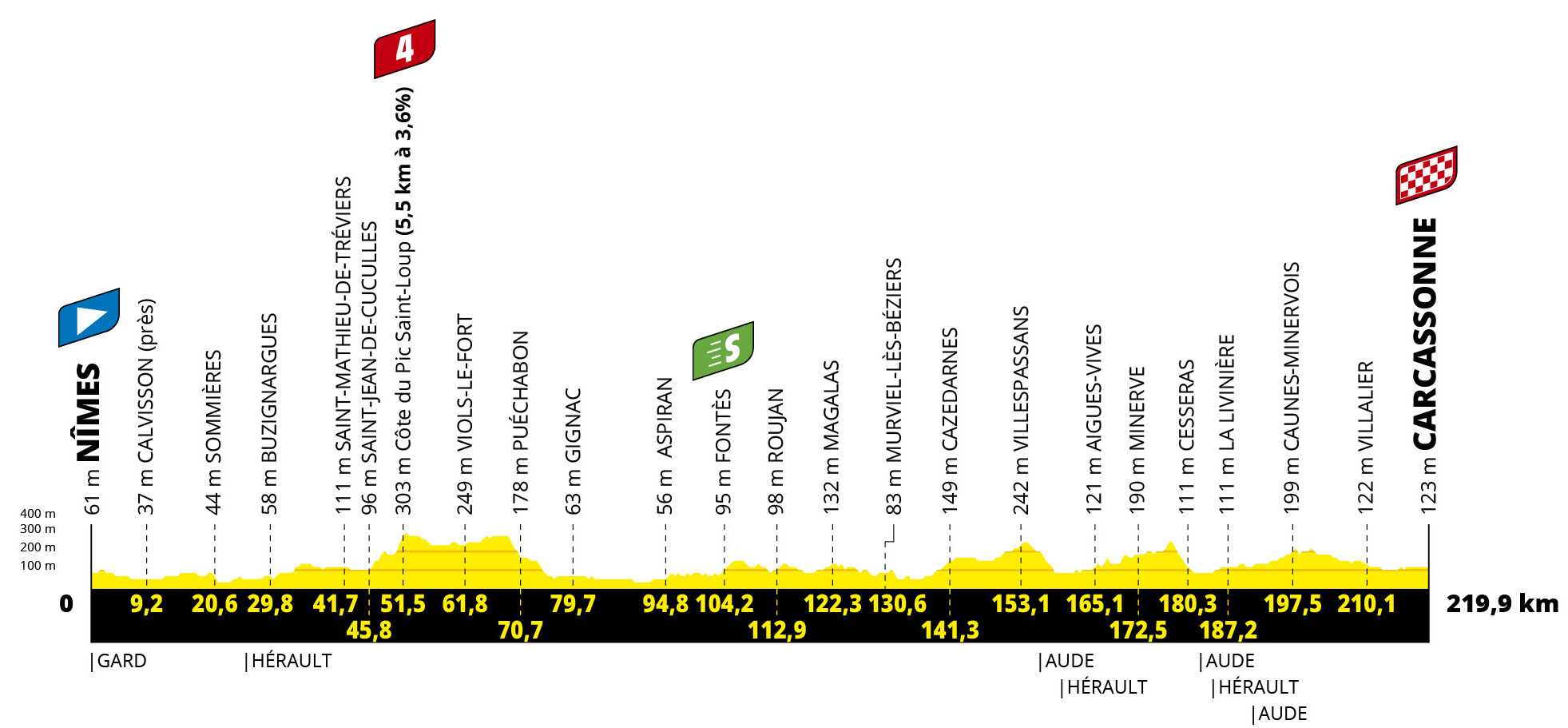
Another sprint stage with the same caveats about the crosswinds before the finish in Carcassonne and its medieval-style ramparts, style as in it looks old but is really an invention from the late 19th century.
Stage 14 – Saturday 10 July

If you had to pick one stage to ride as a tourist it’d be this for the scenery and the pleasure of the course in a corner of France that the Tour doesn’t use enough, the final climb to the Col de Saint-Louis even features a fun spiral bridge to help gain altitude. Race-wise it’s a great day for the breakaway.
Stage 15 – Sunday 11 July
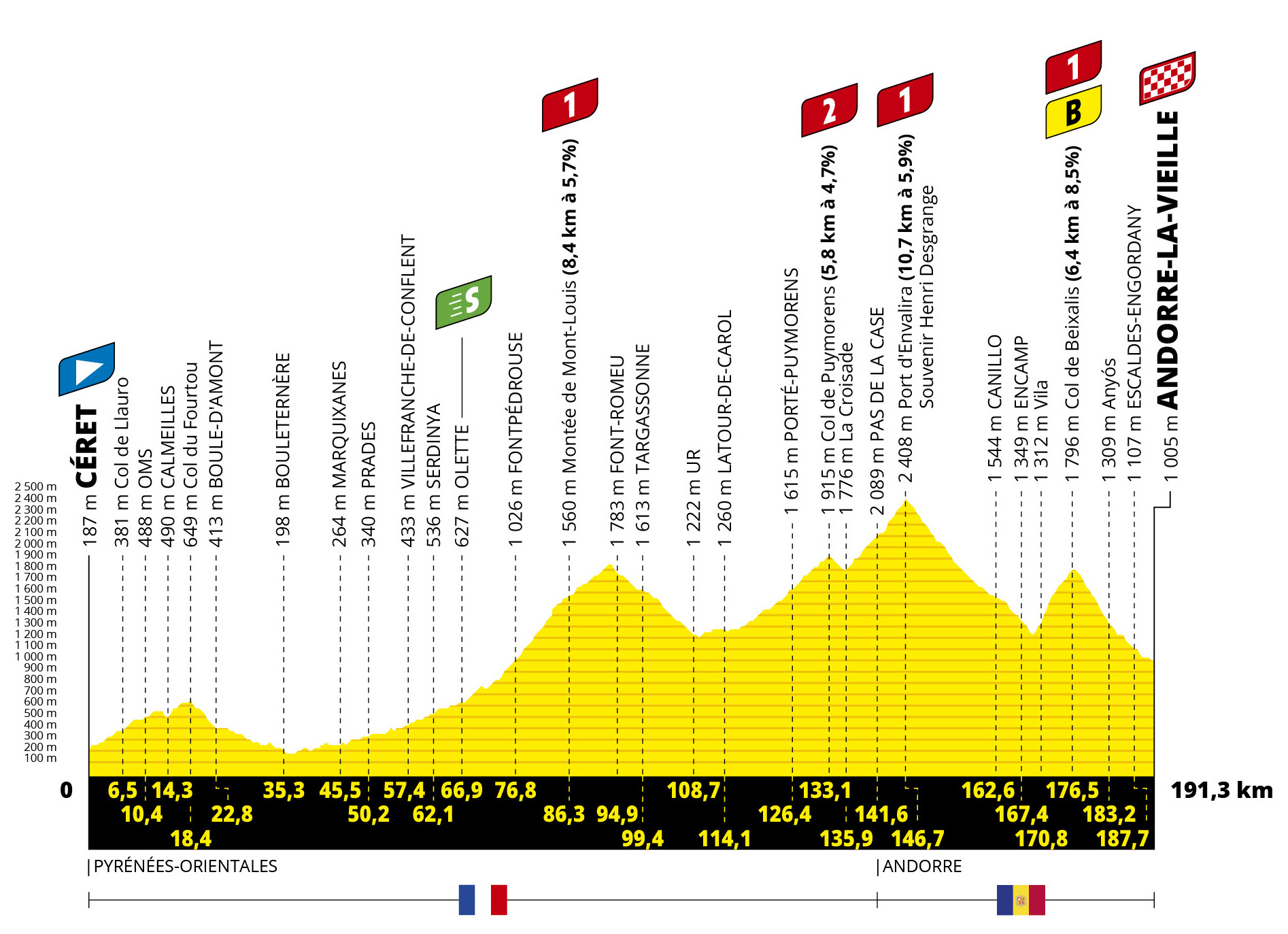
A visit to Andorra via some big, gradual climbs before a sudden change and the sharp serpentine ascent of the Col de Beixalis, a staple of the Vuelta in recent years, and a descent back to down. There’s a rest day in Andorra.
Stage 16 – Tuesday 13 July
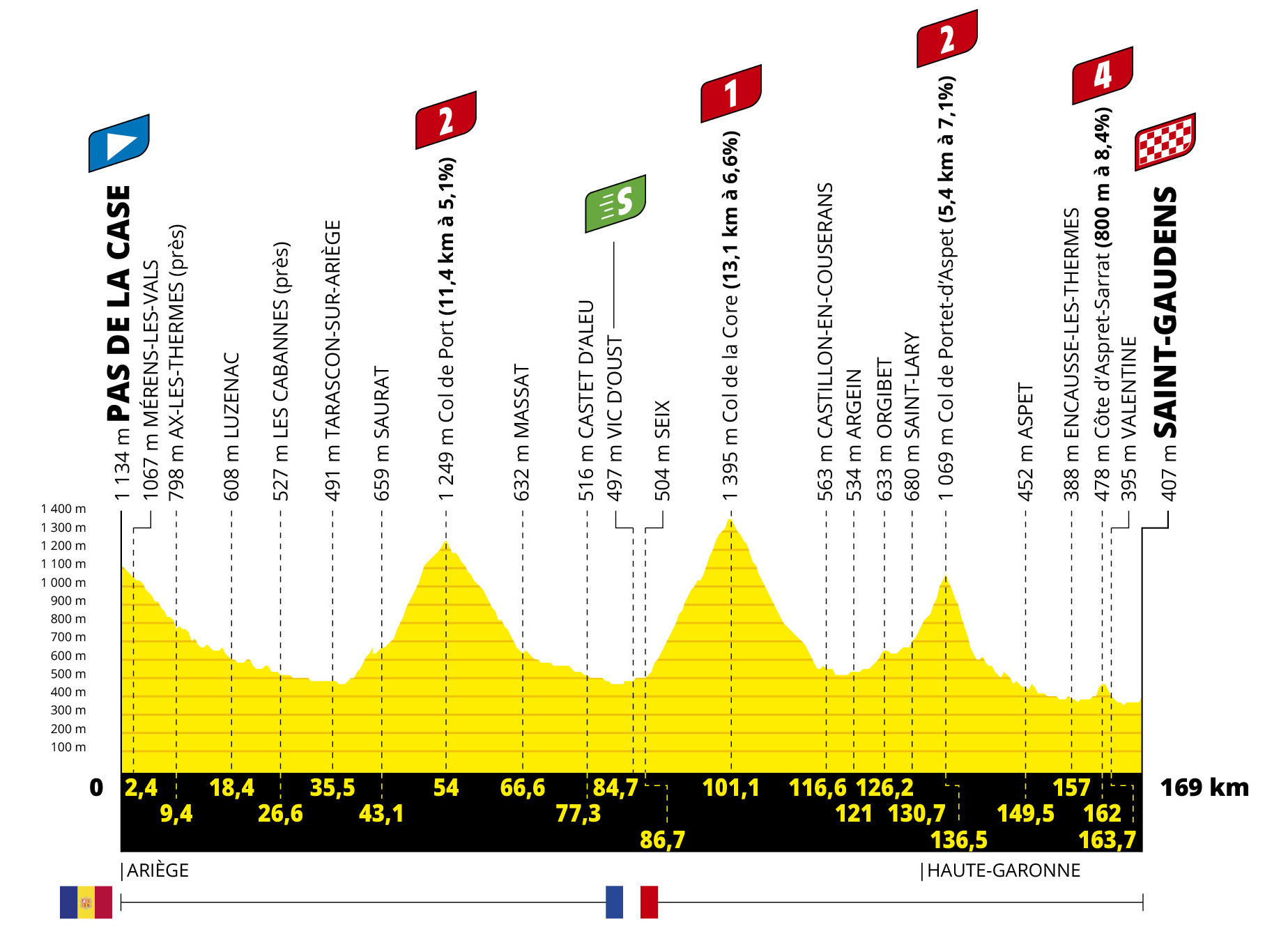
Out of Andorra but rather than climbing out, it’s a downhill run to spare anyone who got their rest day wrong à la Anquetil in 1964. Three hard passes are in the way, the average percentages don’t sound hard but they’re flattered and flattened by gentle starts to each climb. There’s a late climb 8km from the finish but it’s more ramp than wall.
Stage 17 – Wednesday 14 July
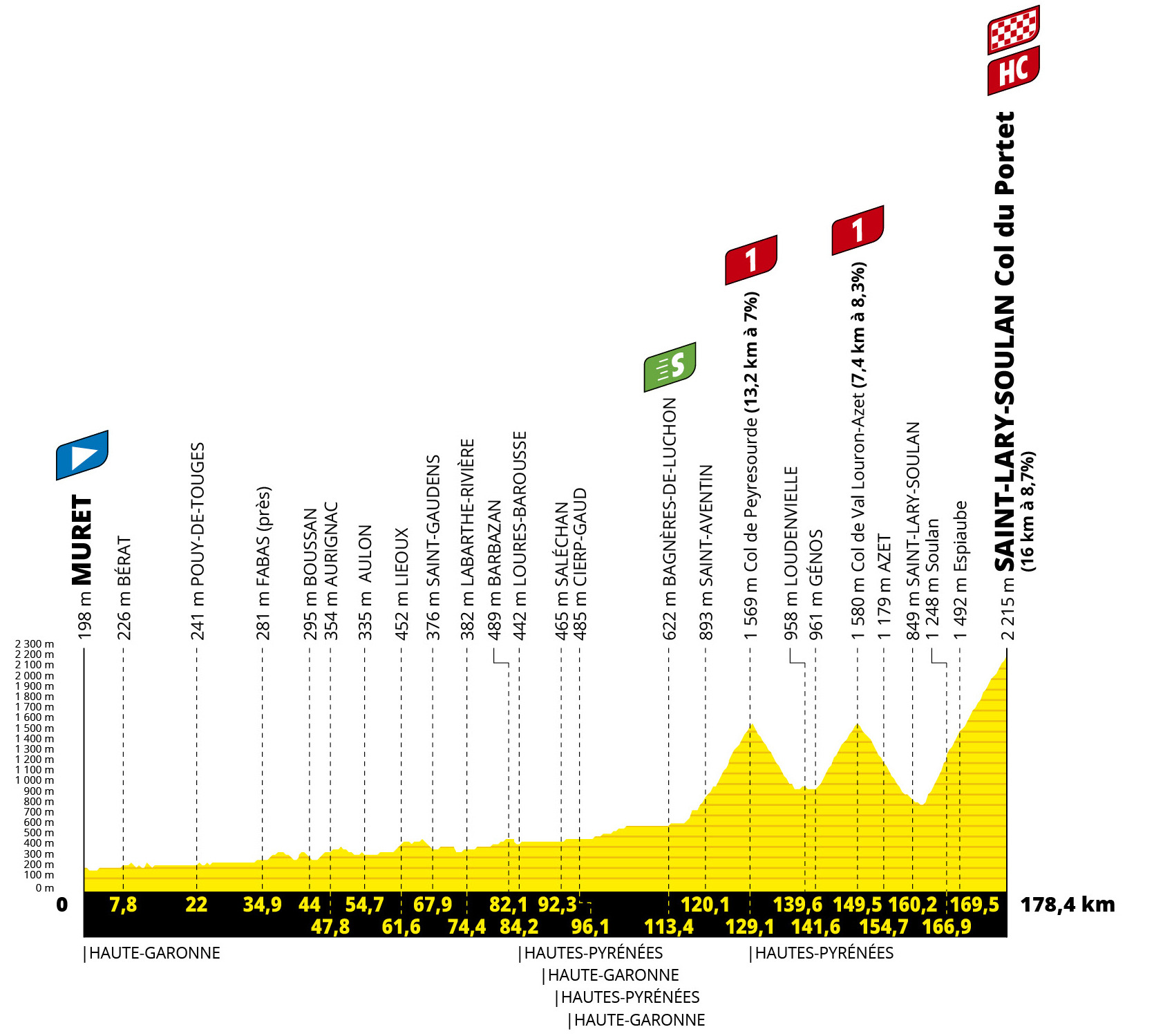
Bastille Day which means big crowds. A dash across the plains before colliding with the Peyresourde, a big boulevard of a climb and a fast descent into the twisty climb of Val Louron-Azet and an even twistier descent. Then comes the “new” Col du Portet, it’s the first part of the Pla d’Adet accesss road, then the upper section was tarmacked in 2018 just in time for the Tour de France’s visit, a day when Nairo Quintana won and Chris Froome cracked. It’s now the highest paved pass in the French Pyrenees and a very hard climb.
Stage 18 – Thursday 15 July

Short in distance, big on altitude with the Tourmalet and then Luz Ardiden summit finish, a crunch day for the mountains competition.
Stage 19 – Friday 16 July
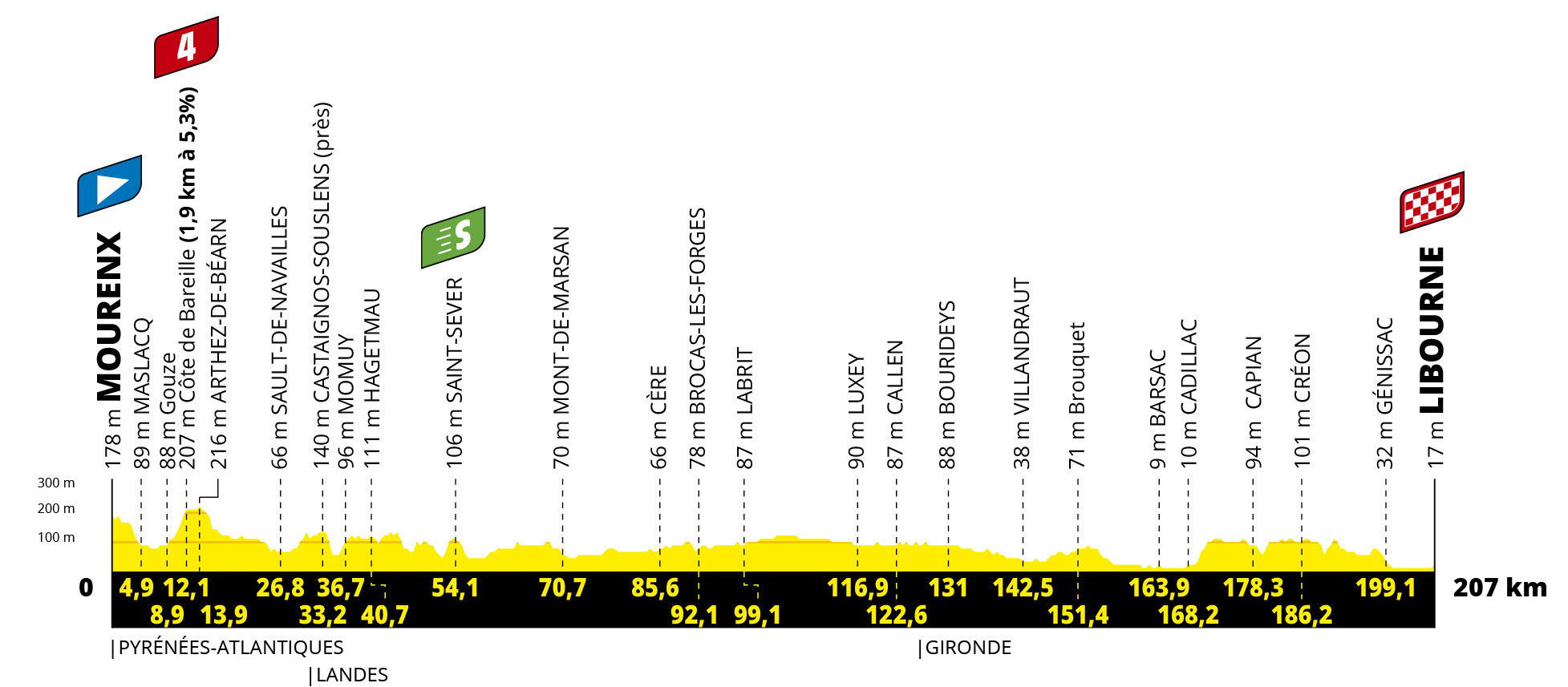
A sprint stage, in the past the race would have gone to the nearby city of Bordeaux but the townhall’s less keen on the Tour, so Libourne, gets the publicity. The talk is the Tour will return to Bordeaux soon.
Stage 20 – Saturday 17 July
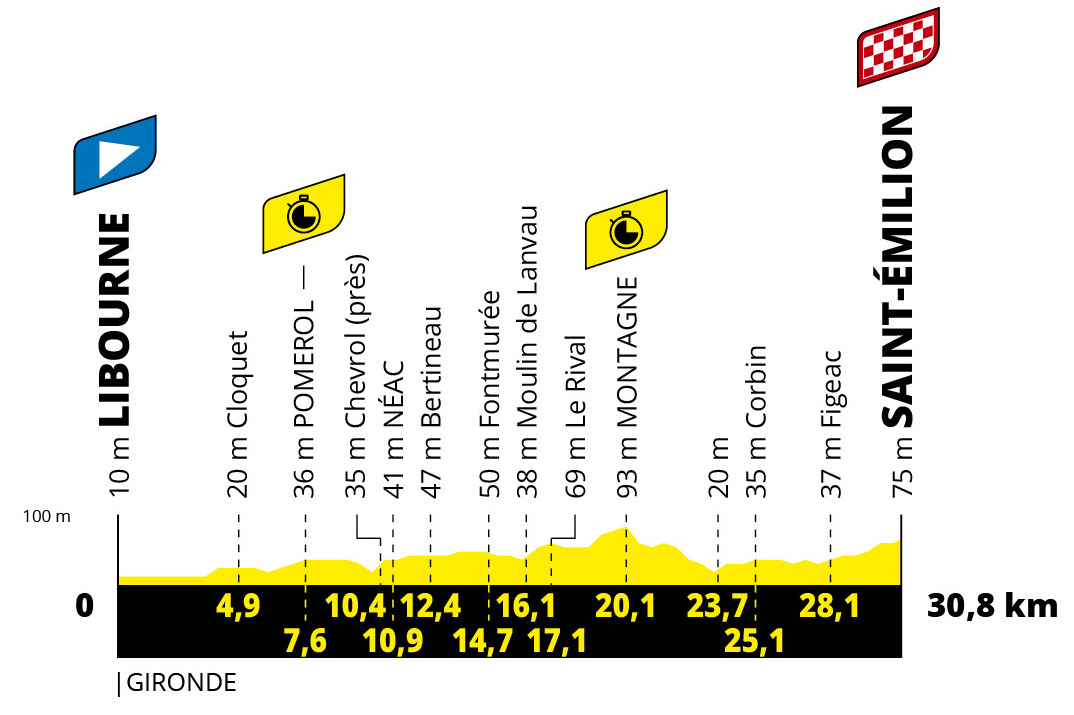
A time trial with a route that reads like a wine menu, this 30km course rides past many famous vineyards and châteaux. The difficulty is the lack of difficulty, of GC contenders having to push a huge gear on the fourth Saturday of the race in order to secure their overall position.
Stage 21 – Sunday 18 July

The usual 60km parade that mutates into a 60km criterium and the finish on the Champs Elysées. Some riders will be in a hurry as there’s a flight waiting at Charles de Gaulle airport to take them to Tokyo.
The Jerseys

Yellow: the most famous one, the maillot jaune, it is awarded to the rider with the shortest overall time for all the stages added together, the rider who has covered the course faster than anyone else. First awarded in 1919, it is yellow because the race was organised by the newspaper L’Auto which was printed on yellow paper. Today it is sponsored by LCL, a bank. There are time bonuses of 10-6-4 seconds for the finish of each stage except the time trials. There are also 8-5-2 seconds at the bonus sprints marked “B” on the profiles above, typically atop various mountain passes.
Green: the points jersey, which tends to reward the sprinters. Points are awarded at the finish line and at one intermediate point in the stage and the rider with the most points wears the jersey. It is sponsored by Skoda, a car manufacturer
- Flat stages (Stages 1,2,3,4,6,10,12,13,19,21) 50-30-20-18-16-14-12-10-8-7-6-5-4-3 and 2 points for the first 15 riders
- Hilly finish / Medium mountain stages (Stages 7,14,16): 30-25-22-19-17-15-13-11-9-7-6- 5-4-3-2 points
- Mountain Stages + individual TT (Stages 5,8,9,11,15,17,18,20) : 20-17-15-13-11- 10-9-8-7-6-5-4-3-2-1 points
- Intermediate sprints: 20-17-15-13-11-10-9-8-7-6-5-4-3-2-1 points
Polka dot: also known as the “King of the Mountains” jersey, points are awarded at the top of categorised climbs and mountain passes, with these graded from the easier 4th category to the hors catégorie climbs which are so hard they are off the scale. In reality these gradings are subjective. Again the rider with the most points wears the jersey. It is sponsored by Leclerc, a supermarket.
- Hors Catégorie double (3 in total): 40-30-24-20-16-12-8-4 points, these are HC climbs but points are doubled for the second time up Mont Ventoux and for the summit finishes of Stages 17 and 18.
- Hors Catégorie (2): 20-15-12-10-8-6-4-2 points
- Category 1 climbs (13): 10-8-6-4-2-1 points
- Category 2 (9): 5-3-2-1 points
- Category 3 (10): 2-1 points
- Category 4 (23): 1 point
White: for the best young rider, this is awarded on the same basis as the yellow jersey, except the rider must be born after 1 January 1996, ie aged 25 or under. It is sponsored by Krys, a retail chain of opticians
If a rider leads several classifications, they take the most prestigious jersey for themselves and the number two ranked rider in the other competition gets to wear the other jersey. For example if a rider has both the yellow jersey and the mountains jersey they’ll wear yellow while whoever is second in the mountains jersey will sport the polka dot jersey. If a rider has all the jerseys the priority yellow, green, polka dot then white.
There’s also a daily “most combative” prize awarded every day to the rider who has attacked the most or tried the hardest. It is a subjective prize and awarded by a jury. The rider gets to stand on the podium after the stage and wear a red race number the next day. There will be a final Supercombatif prize with involvement from the jury and social media. It is sponsored by Antargaz, a bottled gas company.
Timekeeping
Normally a one second gap on the finish line is needed to separate groups in a finish but for Stages 3,4, 6, 10, 12, 13, 19 and 21, the likely sprint stages, three seconds is needed for a split in the field. The three kilometre rule doesn’t apply on Stages 1, 2, 5, 9, 17, 18 and 20.
Time Cuts

Stages are given a coefficient rating from 1-6, look up the stage in question in the table above. Then see the average speed for the day’s winner and look up the corresponding line below.
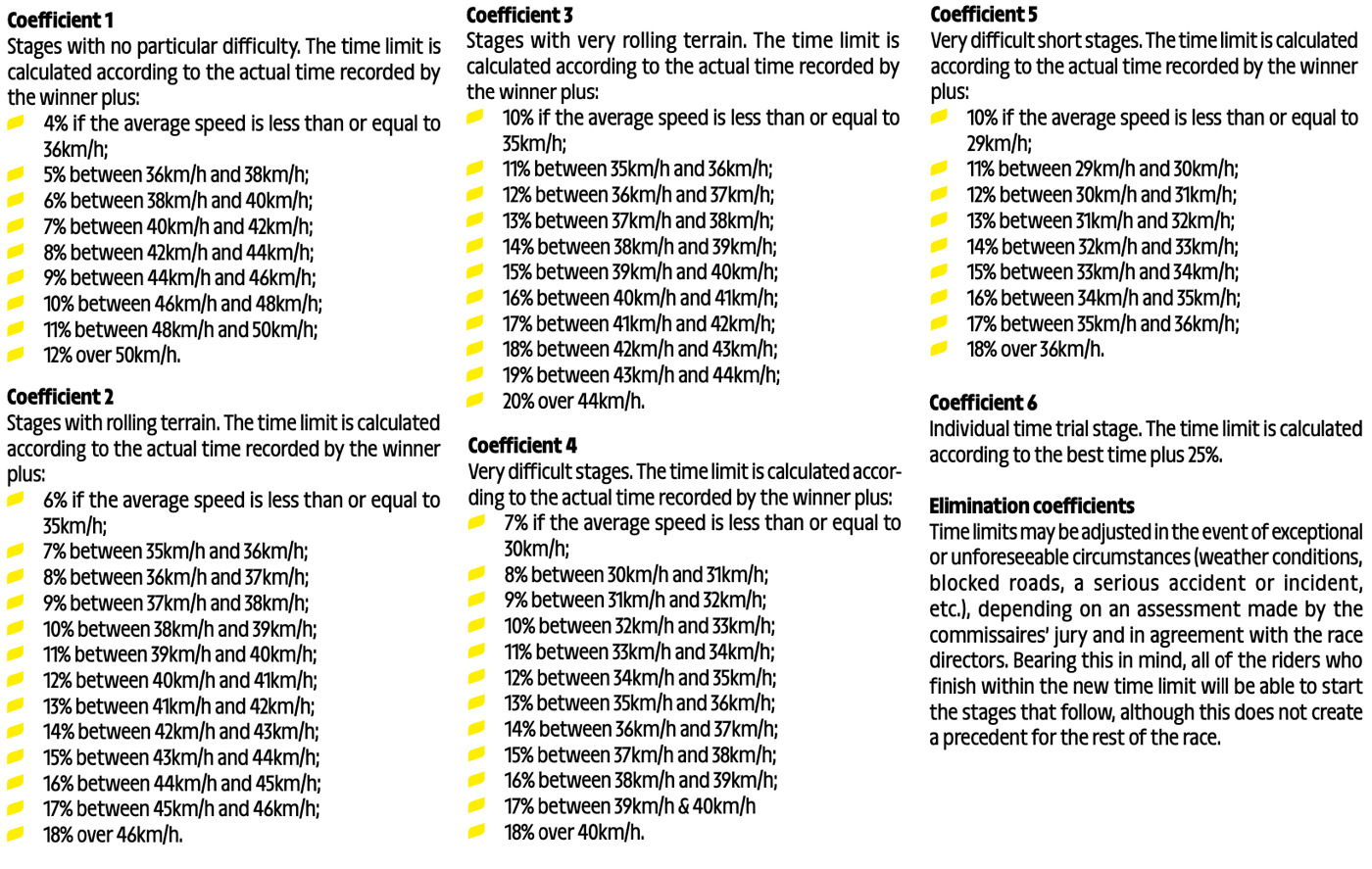
The unmissable stages
This is the Tour de France and there’s always something to watch but there are some stages that matter more than others. If you need to plan ahead, here are some suggestions:
- Stage 1: the prestige of the yellow jersey awaits the winner
- Stage 7: the longest stage, don’t tune in all day but the finish could be interesting
- Stage 8: into the Alps
- Stage 9: The Pré and Roselend before the slog to Tignes
- Stage 11: Mont Ventoux
- Stage 14: the fight to get in the breakaway and then to see how the finish plays out
- Stage 15: the Beixalis climb towards the finish in Andorra
- Stage 17: the Col du Portet summit finish
- Stages 18: the Tourmalet and Luz Ardiden summit finish
- Stage 20: the final time trial to decide the GC
TV Guide
Every stage will be shown live from start to finish. Think of it like the radio, something to have in the background, or tune in from time-to-time via your phone in case there’s early action. The daily finish time varies between 5.00pm-5.40pm CEST.
The race will be broadcast on a variety of channels around the world. There is no free stream on the internet but you will find a feast of legitimate feeds from local broadcasters and international sources like Eurosport-GCN.

The Prizes
- Each day on a normal stage there’s €11,000 for the winner, €5,500 for second place and a decreasing scale down to a modest €300 for 20th place
- For the final overall classification in Paris, first place brings in €500,000 and the Sèvres porcelain “omnisports trophy”, awarded “in the name of the Presidency of the French Republic”. The full breakdown is €500,000 for first place, €200,000 for second place, €100,000 for third place and then €70,000, €50,000, €23,000, €11,500, €7,600, €4,500, €3,800, €3,000, €2,700, €2,500, €2,100, €2,000 €1,500, €1,300, €1,200 and €1,100 for 19th place. €1000 for 20th-160th overall
There are other pots of money available in the race:
- €500 a day to whoever wears the yellow jersey, €300 for the other jersey holders
- €25,000 for the final winner of the green and polka dot jerseys
- €20,000 for the final winner of the white jersey
- There’s also money for the first three in the intermediate sprint each day: €1,500, €1000 and €500
- The climbs have cash too with the first three over an HC climb earning €800, €450 and €300 and lesser sums for lesser climbs
- The highest point in the race sees a prize when on Stage 15 the Henri Desgrange prize is awarded at the top of the Port d’Envalira and is worth €5,000, the Jacques Goddet prize is also €5,000 for the first over the Tourmalet
- The “most combative” prize is awarded and worth €2,000 each day, the “Super combative” prize is awarded in Paris and the winner collects €20,000.
- There’s also a team prize with €2,800 awarded each day to the leading team on the overall, €50,000 for the final winners in Paris. Note the team prize is calculated by adding the time of the best three riders each day rather than the best three on GC. For example if a team has riders A, B and C make the winning break one day then their times for the stage are taken and added together. If riders X, Y and Z on the same team go up the road the next day, their times are taken. So it’s the times of a team’s best three riders each day as opposed to the best three riders overall.
The total prize pot is €2,288,450, meagre for an event of this scale but remember that unlike, say tennis or golf, pro cyclists are salaried and prize money instead is incidental, a nice bonus on the side. Win a Tour stage and a rider might add a zero onto the salary, maybe more and so the race creates value rather than paying it. Anyway prize money is shared around the team (as well as levied and taxed) rather than pocketed by the winner, it’s quite possible the actual prize winner collects 5-10% of the headline sum. In addition, every team that starts gets paid €51,243 to cover expenses. And should a squad make it to Paris with six or more riders they stand to collect an additional €1,600 bonus for each rider.


Thank you, I’ve been looking forward to this. It’s hard not to see MvdP spending a good chunk of the first week in yellow, with perhaps WvA taking over after stage 5 if he’s allowed to go for top three finishes in some of the first four stages.
MvdP is the obvious pick for the opening stage but curious to see what WvA does. If Jumbo-Visma really want to win the Tour then WvA would lead out/play bodyguard for Roglič but they probably don’t have this sole focus. To return to last year’s Tour with some special hindsight glasses, the stage Jumbo set up WvA for the stage win in the crosswinds was fun but they could have buried Pogačar that day if WvA had pulled hard. They played for the stage win and won, good for them. But this would cost Roglič later.
I suspect it will be a different game this year. last year Jumbo were the strongest team, I guess they thought they had energy to spare letting WvA go for stages. This time around Ineos look to be by far the strongest team & Jumbo not as strong (though Jonas Vingegard looks to be a handy addition). Given MvdP’s predilection for somewhat off the wall tactics not sure that anyone from Jumbo should be wasting energy chasing him if they want to win the race. Let MvdP have his yellow jersey and then pack up early to head off to Tokyo whilst Jumbo concentrates on trying to derail the Ineos juggernaut.
Not for me.
Jumbo-Visma *and* Ineos get their shit together and get rid of Pogacar anyhow, anyway and any chance they can, first and foremost.
Then see how the rest plays out.
Pogacar has to be public enemy number one in the peloton.
Fight the power.
“In addition, every team that starts gets paid €51,243 to cover expenses. And should a squad make it to Paris with six or more riders they stand to collect an additional €1,600 bonus for each rider.”
My first time seeing Le Grand Boucle back in 1988, 7/Eleven’s Ochowicz told us the team had to PAY $30 K to enter and in return got “entry, two cars, room and board…and a couple of towels.” 🙂
Vive LeTour!
Teams today would pay even more, arguably they through the World Tour licence system, whether it’s building a roster to qualify or the fixed UCI fees etc.
Does the UCI impose anything on ASO, such as the appearance money? ASO could more or less charge what they like for teams and athletes to get the exposure. (Not so strange because it’s sort of what the Olympics does, after all. No appearance money there, and the owner keeps all the sponsor and broadcasting rights money.)
That’s the point of the World Tour, all races are open to the World Tour teams rather than letting organisers pick who they want, or even charge and having all the resulting complications. There is a small compulsory “participation fee” that all World Tour races must pay teams for taking part. Some races/organisers do pay appearance money, eg RCS, typically for a particular rider but the money is usually paid to the team so the team gets a slice too.
Yes.
WT race organisers must pay a mandatory participation fee to every team, provide all accommodation and costs for the transfer legs.
In return they have the right to eject a team (or particular team member/s) which brings the race into disrepute.
Larry T – Effectively, it’s the same thing, no? In 1988 the team paid $30,000 for hotel, two car rentals, and race entry. Now, in 2021, the team has to pay its expenses (which are much higher than in 1988) and it gets a stipend of $51,243 to help cover the costs… this effectively is no change.
Teams don’t pay for cars any longer, cars are provided by sponsors… there is no entry fee, as this is covered by race sponsors (start towns, companies, etc.).
Vive Le Beeg Shew.
Stages 1, 2 and 7 enliven an otherwise unexciting first seven days, but I suppose the ITT will produce meaningful gaps so there’ll be some interest there for those less interested in watching people ride against the clock.
That finish at Tignes – 21.5km at 5.6% – almost guarantees processional racing, and yet it keeps turning up. They must be paying well.
I like the double Ventoux idea.
My annual grumble of a lack of puncheur stages – often the most exciting – do we really need seven sprint stages?
And while I’m at that, as ever these days there isn’t a long (>220km, at least) stage with multiple big mountains. A good grand tour route should include one of these as a GT should cover all facets of riding. They’re also often far more interesting, tactically, than a dash up a final mountain (for anyone who wishes to claim that they’re ‘dull and neutralised by the riders’, Gabriele has a long list of examples that prove this isn’t the case). Occasionally, they even result in the GC riders actually racing each other for a few dozen kilometres, rather than just the final 1-5km.
As for the “Classics-like” stages, I think that 1-2-7-14, plus 16 depending a lot on how it plays out (but, well, if it turns out to be for stage hunters, it would be still less interesting than if some bold contender turns it into a GC battle) isn’t that much – totalling 4-5 stages – but it isn’t that poor, either. I agree that I’d tilt it with a +1 of sort, taking it away from the pure sprints.
More than anything else, the distribution isn’t perhaps that great: they make for an interesting first week (in which I include stage 8 and 9, especially the former), but the second and third week could end up being a little impoverished, if the wind doesn’t help, even more so given that they don’t have sooo many great mountain stages either (a couple each – and maybe not all of them could be actually defined “great”).
Châteauroux was also a major railway junction on the Paris Austerlitz-Limoges-Toulouse main line before TGVs took its life, meaning and station buffet clients away. The Tour has a major role in bringing crowds and visibility to sleepy and slowly decaying rural towns (Châteauroux, like so many, has lost nearly 20% of its population over the last forty years). Many people in France will have a memory of waiting for a delayed train in Châteauroux.
Like nearby Vierzon as well, on the same railway line. I think have links to the tobacco industry which is obviously in decline, Châteauroux has had a big US army base in the past which has also gone. It’s a huge wheat growing area, all those baguettes consumed every day rely on areas like this.
Isn’t it, most importantly, the hometown of the greatest cyclist of the decade, of the century, of the millenium : Sylvain Chavanel ? But I think he would say that this short stage – 160km – would be an “étape de mickey”…
He’s from Le Chatre… not far away but another place. He’s now in a second career as a jockey (and horse owner) and doing ok, he won for the first time a month ago.
I believed I knew something, and I did not (isn’t it La Châtre though ? I got confused in my Indre cities). Thank you for the update anyway ! So maybe he should say now that this is an étape de jockey.
Coming back to Chateauroux, there was a story about the construction of a big chinese sports center to prepare chinese athlets for the Paris Olympic Games, but I don’t know if it is still the plan.
It’s a travesty with all those mountains, it should be flat 10 stages, a five-six mountains and then 7-8 tt 100+ km stages all sorts of terrain. Isn’t this “best rider over 3 weeks”? Not richest team. Many riders can’t TT you say? well, then they aren’t good riders. The only way to difference the weak against the strong, is how good they are alone. Have 50/50 mountain/flat TTs then.
Yes, the way it always used to be.
Oh… wait.
Still, never mind. Let’s plough on into this exciting new world of watching 10 flat stages and >700km of time trials.
Let’s take a complex, tactically nuanced sport that has sometimes been called ‘chess on wheels’ and turn it into a contest purely of ‘Who has the best legs?’ Imagine the thrills.
Actually, why not make it 21 days of time trials? That would separate the strong from the weak even more.
Icosagonal wheels too! None of this round nonsense – far too easy.
On zwift perhaps so we dont become sidetracked by the scenery.
And we could test bike handling skills by dumping engine oil at the roundabouts and corners.
Just to say, I think those two first stages are in the “flat” cat
You’ve obviously not been to Brittany. Whilst it doesn’t have any mountains it’s quite lumpy and not pan flat like say zeeland
Agreed, it’s up and down all the time, what Mike calls “flat” has over 2,500m of vertical gain on the first day, a bit less the next.
Totally. My abiding memory of the place is that it’s made of a ripple of hills – the cliche is that it’s just like Cornwall which is sort of a nightmare on the bike. There are no flat roads, and every decent has you scrubbing off speed because the roads wind and twist in unpredictable ways.
About those hills. Haven’t been there, but what’s described sounds similar to the Missouri Bottom roads in the state of Missouri, where I grew up and rode them a bit.
That’s hard riding. I believe Hincapie said that stage of the Tour of Missouri that went through there (He won it, I think), was the hardest race He ever did.
I’d rather ride any of these mountain passes here in Colorado, which are all around Me.
So, I don’t think they’re in the flat category.
The first week is a prologue short of being properly old school with the sprint stages, TT and 250km stage. The mountain stages are pretty modern though in that they all seem to be 150km or less.
This being “old school”? Old school Tour usually had no decent climbing at all for at least 8 (eight!) stages… barely any hill.
I’m speaking of the unbearable Leblanc era, obviously (1989-2005), but the format – way different from the standard of the 70s and before – had been already established little by little during the 80s, although it was Leblanc who made it so rigid, obsessive and boring. Incredibly similar to what a reader suggested here a few days back (tongue in cheek, I suspect): 7-8 sprint stages who could eventually be won by some break out of power play among sprinter teams, plus one or two flat TTs (prologue, ITT, or TTT).
Lethal – but very recognizable, as well as formulaic. Previous courses were quite much diverse and entertaining, indeed, although it’s hard to see such a common pattern among them.
This year’s first week (that is, the first 9 stages, actually) looks quite a lot more akin to the standard set by the Giro: an ITT, 2-3 for the sprinters, 2-3 for the Classics guys (1-2 of which potentially dangerous for the GC men), a difficult mountain stage (but no marathon, and maybe with no hilltop finish) and an easier hilltop finish good for a reduced “bunch sprint” among GC men.
I quite much like it (the first week, I mean). There’s a long, serious, tricky stage and I don’t care if the mountain stages are short, this soon – you could have some of it later on (which, sadly, is not as much the case this year: but that’s a problem of the other two weeks).
“I’m speaking of the unbearable Leblanc era, obviously (1989-2005), but the format – way different from the standard of the 70s and before..”
Sadly for me, I started following LeTour in 1988 and stopped (as in guiding large groups) in 1998 so my experience is pretty much only that. But VIVE LETOUR anyway.
David Guinea just tweeted a map of the 1981 course and, man, that was really something…
I guess that Guinea is autocorrection for David Guénel 😉
Great account!
About the 1981 course, dunno, four ITTs (including prologue), two TTTs (including a “semitappa”), just some four serious mountain stages, two of which shorter than 140 km, never climbing above 2,000 mts, a lot of sprint stages… No surprise that it was the shortest and fastest TdF for a good span of years. Hinault coming back from the previous edition’s disappointment to win easily against weak competition.
However, I wasn’t around to actually watch it, so perhaps I just got it wrong from historical documents.
In 1981, Hinault was at the height of his might, but it was still a very good race (albeit not very montainous), especially the first week. The flat stages were generally long enough to cause serious attrition, the were packed with time bonus sprints to keep everybody awake, and there were TTT to generate further GC movement. Then the Pyrenees quite early in the race, then a flat ITT. And then the Roubaix pavé… One thought: when riders who do not climb too well are still able to contest the podium, it makes for very good racing.
Absolutely uninspiring course.
Some steps forward when compared with some past, recent editions, but, all in all, quite mediocre, except perhaps a lively first week (9 stages).
The second week has got too much sprinting (3/6!) which isn’t great if the wind doesn’t blow.
The other 3 are solid (2 serious and long enough mountain stages, a tricky hilly one), although mountains are too separated between them – both in the sense that the stages are not consecutive ones, and that the climbs they include are also too far off the one from another: both factors equally favour superior team firepower over individual valour.
The third week is Vueltish – not the very last Vueltas, either, more like when ASO was making experiments to cut it down to two weeks, hence offering weak third weeks.
Short mountain stages – let’s hope they’ll be explosive, but where’s some good ol’ fondo? The most interesting design, on stage 17, risks to be spoilt by the evidently superior impact of the final climb, which, being so hard, could reduce the rest to being pretty much meaningless. I suspect that stage 18 could even end up being more interesting, despite its U23 length. The ITT is pretty much “meh”, too.
Any insight as to why the Bordelais and Bordelaises of the Bordeaux city hall have soured on the tour? Is it simply financial?
Thanks very much for this, and in enough time to book the relevant days off work.
Disappointing, however, to see that the classic line, “they’d get too hot” has been pensioned off!
+1
Hopefully the ‘jerseys … get too hot’ line only got lost in editing and will be restored for the Vuelta.
Thanks for the excellent and detailed tour guide. Nowhere else do you get this level of detail and commentary on a tour breakdown.
Looking forward to some excellent stages. It’s always a bit pointless anticipating too much from the Tour. Many fans seem to have polarised rose tinted magnifying lenses which seem to magnify legends of the past while diminishing the race they are watching, until time improves the flavour of the vintage. I think some of this is due to the way our brains condense and distil information – we think about the important moments, whereas following a tour is in fact a slow drawn out slug fest. Landing too many punches early can end in fatigue with your opponents lasting the course and destroying you in the final rounds.
Much of what makes a good tour is the competition. How close and competitive the main protagonists are, and whether they stay the course is what helps create those epic moments.
I’m looking forward to Mont Ventoux. The decent off down the Maulaucene side is fast and treacherous. With no real bends to take the speed off riders are going to hit some top speeds. It makes me wonder how many will use disc brakes on this.
Not keen on these big downhill finishes, seems a recipe for crashes to me.
I think the rules require the bikes to have working brakes on both wheels. Nobody’s putting a gun to anyone’s head to take risks on descents, despite what Andy Schleck used to whine. If you suck going downhill you’ll just have to get up the hill faster than the guys who are good going down. That’s why (at least so far, thank gawd) they don’t hand out yellow jerseys in Paris based on what someone does on Zwift.
Heh.
But you can read on this page people complaining about the old days, so they’re not looking with rose-tinted glasses. People have their opinions on the course: they’re not saying ‘It should be like it was in…’
If that were true, given that there are loads of “uninspired” comments above, why do people, especially on this site, watch and follow this, the “biggest cycle race on the planet” at all..? You all love it, but expectations run so high they can never live up to the memory of the past.
Nothing to do with the past. Only you are talking about that (apart from when gabriele talked about how rubbish the courses of the past were).
Nothing to do with all loving it. You also don’t know that.
Nor do you know anything about others’ expectations. Everything you’ve said is conjecture.
Others are critiquing the course. You are claiming knowledge of why they are doing that, but you don’t know these people at all.
“It makes me wonder how many will use disc brakes on this.” Do you think they are a plus or minus under these conditions? Froome seems to think they’re a minus but other than his former team (and perhaps UAE with Colnago?) does anyone else have a choice?
Stages like these are why Banesto tire sponsor Wolber (owned by Michelin) used to quietly put BigMig on clincher wheels since the heat of braking generated by traditional rim brakes would soften the tubular glue enough for the tire to shift, giving Mig a lumpy ride.
Interesting take during the first or second episode of the Team Movistar doc/TV show, I think… all riders complaining a lot about shifting from rim to disc *and* from Campy to SRAM. I think that was pretty much sincere (as the rest of the footage, by the way) given that they’re still on the same brand, looks like little PR clean-up was made, although they can always use the line “yeah, last season they sucked but we stayed with them because *now* they’re really great”.
There’s some rift with the mechs which feel they’re being blamed for the situation, but everybody insists it’s actually the materials.
I’m an unabashed Campagnolo-phile and when I think of SRAM I think of the crappy Grip-Shift junk fitted to cheap MTB’s back when I was in bike retail.
Most have seen Mollema’s review of SRAM I assume, but just-in-case: https://www.youtube.com/watch?v=Tsk3zAZyLaQ
But when the fat checks get written the pro riders get to use what they’re given, no matter what their personal preference might be, as Mollema’s “review” demonstrates. My guess is he’s been told to keep further reviews to himself? I’d hate to be a team tech forced to install and try to make that stuff work. As a motorcycle mechanic friend used to say, “You can’t make chicken soup out of chicken s__t, my friend.”
I didn’t take enough from (the translated subtitles of) the episode to be able to tell whether they had specific complaints about SRAM, or whether it was a general complaint about changing to something new and unfamiliar. It seemed the latter, but I also prefer Campag to SRAM, so wouldn’t be surprised if it was the former too.
As I understand it, currently, it’s a negative. So will be interesting to see if they stick with them (which I presume would be sponsor pressure) or safety, and go for rim brakes.
Are you pointing out low opinion of SRAM’s disc brakes vs the others? I sat through a few tech seminars on them awhile back and came away very unimpressed, recalling my bike shop friends while noting the braking products on offer from them came from a company called AVID, one of the (many) companies SRAM bought up over the years.
They joked that the name should have included an O…as in AVOID.
Larry. Having ridden a tandem down Mt Ventoux Alpe de Huez et al I can attest to the quality of Avid brakes. Sadly now out of production.
Colin E – after sitting through the tech seminar I decided I wouldn’t ride around the block with the hydraulic brakes SRAM was showing us. I asked about ’em at my LBS once I returned from the seminars and they said they hated ’em, going on about setting up a client’s bike and him leaving it inside a car in the sun for a few hours…and having the brakes fail to work when he took it out to ride it!
Not my idea of reliable braking performance…but what do I know…I still rely on those metal clamp things that use steel cables to squeeze rubbery brake blocks against aluminum wheel rims to control my speed. Despite decades of fun, high-speed descending on the likes of Ventoux, Alpe d’Huez and countless Dolomite and Italian alpine roads, I can count the times I thought I might be getting close to the limits of braking performance on one-hand..and have a finger or two left.
Perhaps it’s advanced age but if it works, I’m not big on “fixing” it so IMHO disc brakes are an answer to a question nobody asked unless it was how to make a whole bunch of perfectly good bicycles suddenly seem obsolete.
Larry. You’re missing many of the points about having disc brakes. I don’t know if that is deliberate or through a lack of knowledge.
PS I currently ride rim brakes but I’m keen to have those disc benefits (hint – they’re not all to do with braking).
The giant cooling towers near Saint-Paul-Trois-Châteaux are those of the former uranium enrichment facility. This nuclear power plant has no cooling tower.
Thanks for that clarification. France still leading in nuke power?
Yes – They’re building our (UK) new one.
https://www.theguardian.com/news/2017/dec/21/hinkley-point-c-dreadful-deal-behind-worlds-most-expensive-power-plant
“To pay for it, the British government has entered into a complex financial agreement with Électricité de France (EDF), the energy giant that is 83% owned by the French government, and China General Nuclear Power Group (CGN), a state-run Chinese energy company. Under this contract, British electricity consumers will pay billions over a 35-year period. According to Gérard Magnin, a former EDF director, the French company sees Hinkley as “a way to make the British fund the renaissance of nuclear in France”. He added: “We cannot be sure that in 2060 or 2065, British pensioners, who are currently at school, will not still be paying for the advancement of the nuclear industry in France.”
Thanks for this, useful and insightful as always.
As for the course, I’m just happy to see a fair amount of roads that I’ve been riding and racing on myself. Other than that, I’ll wait and see. The final TT might be dull or a spectacular GC showdown, depending on the competition. Same logic applies to every stage, only not always so obvioisly.
Oh great. A final long weekend of sprint, TT, dull procession. Can’t wait *yawn*.
And yes, I know the TT worked out well last year, but that was good luck rather than good planning. The final weekend of the tour is consistently less interesting than the other two GTs, and pretty much any race, last year’s TT aside 😀
It might be my poor level riding my bike (it surely is), but the end of stage 7 seems very hard to me. From Autun there is no flat anymore, and the hills are very difficult (most of all Uchon, with the last kilometer between 15 and 20%), on small roads. I wouldn’t be surprised if we have GT action there (I would even be disppointed if there is not). MvdP could even attack with 40km to go (at the exit of Autun there a good ramp at 10 %), if he goes with Alaph, VdP, the two slovenians and Carapaz, nobody should see them again… But maybe I’m daydreaming. There could be more gaps than in the Tignes stage, and yes, like Gabriele said, the beginning of the Tour seems very good, the end not so much. Let’s hope we have wind in the second week.
The finish is interesting but it’s on roads I don’t know, aiming to visit in the next two weeks and see how hard or not it is. It could be like the Pavese stage of the Giro, the day Bettiol won from the breakaway where a long flat stage ended with several sharp hills.
The climbs, here, should be pretty much harder than at the Giro (albeit one less). Equally concentrated in some 30 kms with little rest and often on narrow, twisting roads.
However, the Pavese/Conte stage came deep into the third week, whereas the Tour’s will be much sooner; yet, the French version’s got some extra 20 km and a slightly more complicated first 200 kms with at least 1000 m of altitude gain which just weren’t there in the Italian version.
That said, all in all the two stages are quite similar indeed, but I still believe that we’ll see less exhaustion in July – while at the same time there should be more fireworks, given that the climbs are more promising: the very last one is comparable, but those which precede it are a different affair – 5% to 7% in Italy, 7% to 10% (and beyond) in France.
@inrng Curious to see the result of your impressions on the road, the look and feel can be quite different from what I might infer thanks to LaFlammeRouge 😉
Maybe I’m overestimating the stage because it’s on home roads. But I don’t see MvdP not attacking on those kind of roads ; if he attacks, Alaphilippe will try to follow, won’t he ? And if he follows, etc… It might be an intellectual construction.
Anyway, I’m looking forward to see a man with an anonymous black kit and an Inrng cap flashpassing me while I will be suffering and zigzaging on the roads… Enjoy the region, there are some nice views, a nice cathedral in Autun and the countryside is very pleasant (Le Creusot is ugly though).
Moving the chat away from the traditional pre-Tour bellyaching about the route. Who is everyone’s fave this year? I’m thinking this year’s course suits Roglic more than last year’s. Can’t see Pog taking a load of time over 2 flat TT’s, but could (and may well be) wrong. Thomas could do well if he manages to avoid his now regular disaster. Can’t really see beyond those 3.
Something about the way Porte took the Dauphine while everyone was watching Thomas suggests Carapaz could do the same at the Tour. Imagine having Thomas, Porte, Tao, Dennis and likely Kwiato/Rowe/Ganna/Martinez dropping you off inside the final km. *all* they have to do now is neutralise Pog – who is still the strongest rider, but vulnerable to a moment of immaturity IMO.
Exactly, you see how Carapaz moved away on the route to Leukerbad in Switzerland, he can do just the same in Tignes but with 6-7km to go. It’d be shades of 2019 all over again for Thomas who saw Bernal on the attack.
See what you’re saying about Carapaz but is his TT strong enough against Rog and Pog? I know he’s not bad against the clock but I see him losing too much over those 2 stages to be a real threat in the mountains.
Statler and Waldorf are in danger of taking over this comment section with their miserable, over-sensitive, garrulous, self-aggrandising and hypocritical charlatanry.
It is only a minor compensation to see that their performative posturing about old-school cycling means cycling going all the way back to … the 1980s.
Bless their so-very-self-assured little cotton socks.
Ooook boomer! ^__^
IKR?
I need another pair of self-assured Inrng socks, btw…cotton or otherwise…
Oo, oo… and a new jersey – my old one is torn up from some crash I do not even remember (my motto: If you ain’t crashin’, you ain’t ridin’).
I’m not a big fan of mountain stages that finish at the bottom of the descent, i know its a skill to come down quickly, I used to think, man they could take all the drugs in the world to go up the hills faster, but you still have to come down them faster! But now, riders are so close, teams are so strong that unless you risk going early on the climb to get a good lead for the descent, you make 10-20secs max, racing is negated – same can be said for mountain top finishes too… we wait all day until 2km to go and then its a leg flex to the line, all for 10-20 secs again..
I think Ventoux will be the biggest casualty, big break will go, GC wont chase, first time up GC steady, 2nd time up, Jumbo/ Ineos train.. stalemate.
Not sure Pog will win either, happy if he does, but if the wind blows and the races splinters i just don’t see his team being strong enough to protect him.
Lets just hope no silly crashes, all the names come out to play and the lesser lights get their day as well.
The idea seems to be that on a summit finish riders will attack very late anyway meaning there’s only action late in the stage. Add on a descent and you get the late attack… and then 10-20 minutes of sport on top too, that’s what Christian Prudhomme has said in interviews. As you say whether this happens on not we’ll see.